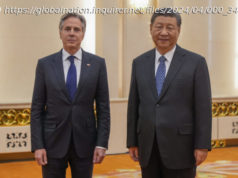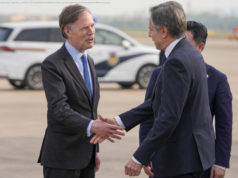Kodak deleted these images of Xinjiang. We’re reprinting them. Plus, a conversation with the photographer.
Earlier this month, Patrick Wack got a boost any photographer would dream of when Kodak’s Instagram account — 841,000 followers and counting — decided to feature ten photographs from his forthcoming book. It’s called “Dust,” and it chronicles the transformation, over the past half-decade, of the Xinjiang region, the cradle of Uyghur civilization, at the hands of the Chinese Communist Party. Then, a few days after Kodak shared the photos, the company deleted them. It didn’t just delete them. It replaced Wack’s haunting pictures with its corporate logo and a statement that reads, in part: “Kodak’s Instagram page is intended to enable creativity by providing a platform for promoting the medium of film. It is not intended to be a platform for political commentary.” It went on to “apologize for any misunderstanding or offense the post may have caused.” Instagram is banned in China, so Kodak put out an additional statement on WeChat, a Chinese social-media platform. This one was more abject: To appease Chinese Communist Party officials, other Western brands — Apple, Airbnb, the NBA, Marriott, Dior and Valentino, to name just a few — have issued similar apologies. Kodak’s Instagram faux pas most closely resembles that of Mercedes-Benz, which, in 2018, posted a #MondayMotivation ad on its Instagram account that included a quote from the Dalai Lama: “Look at situations from all angles, and you will become more open.” The line sparked an uproar in Beijing, and the German carmaker quickly apologized. Wack’s images are far more threatening to the CCP. The photographer calls the situation in Xinjiang, in the northwest region of the country, an “Orwellian dystopia.” He would know. He traveled there six times from 2016 to 2019, documenting the province as it became, in his words, “an open-air prison.” In today’s newsletter, we are proud to reprint Patrick Wack’s stirring images. They are accompanied by a conversation, edited for length and clarity, with him. You can preorder his book here. Suzy Weiss: You were born in France. What drew you to photographing China? Patrick Wack: I first went to China in 2006. I had been working in Berlin, but Shanghai was booming and I had a friend who likewise went from being a hobby photographer to a professional there. Plus, I had this romantic idea of going to a faraway place and documenting it. There was a mix of opportunity and trying to be smart about where to go. You’ve said your project “Out West” started as more of an artistic, visual exercise to show how the development of China’s Western region compared with the conquest of the American West. But that goal shifted when you saw what was happening in Xinjiang to the Uyghurs. What did you see or hear or experience that made you rethink the project? When Out West wrapped in 2017, I thought I was done. But then, in 2018, the news about concentration camps came out. I felt like I had to update the original project, and I knew I was well-situated to go back and document it. I felt it was my responsibility, too, because I had a permanent work visa in China, not a journalist one. Plus, I can speak Mandarin, and I had lived in the country for ten years. I wanted to see how much of the repression of the minorities, and the economic segregation, I could capture. For example, the biggest industry in Xinjiang is hydro-carbons, like gas and construction. I didn’t see a single Uyghur person working there. It was all Han Chinese people. The only people you see working in the cotton fields were Uyghur. They are second-class citizens. And they are in a region that is generating so much wealth — but not for them. So, for my second project, “The Night is Thick,” I had to be more discreet. I couldn’t use film because there were so many checkpoints all the time. They would scan my bags and the x-rays would ruin the film. And I knew I was being surveilled. I only had a digital camera and one lens. You describe your work as a “visual narrative of the region and as a testimony to its abrupt descent into an Orwellian dystopia.” I’d like to know more about that descent. What were some of the most important changes you saw between your first trips to Xinjiang in 2016, and your most recent trip in 2019? There were two major differences. The first was the increase of the police on the ground. In 2016, it was a highly-surveilled region. By 2019, it had become an open air prison filled with police. The officers are all Uyghur people, and they are checking you all the time. You have to go through a body scan and security, just like when you go through an airport, but whenever you enter any public place at all, like a bazaar or a supermarket. There’s also the surveillance you can’t see. There are devices that check the content of phones and apps that record everything. And the cameras are absolutely everywhere. The second major change was in the landscape. The women were not wearing their veils anymore. Any symbol that was Middle Eastern or Muslim had been removed. The mosques were closed or destroyed. You couldn’t hear the call to prayer anymore in the streets. In 2016, the mosques were filled, especially in the towns in the south of the region, which is the cradle of the Uyghur people. In 2019, I didn’t see a single person going to the mosque to pray. Some mosques were open, but only as tourist sites. I also saw a gap in the demographics in the region. There were fewer men in their twenties, thirties and forties out in the streets. My impression was that they were in the camps, but it’s hard to know for sure. That’s what I felt. There was tension and weight all around. Something grim. What is the point of all this watching? What are the Chinese authorities so afraid of? The government says it’s to make the area safer and to secularize it. It’s true there were a lot of incidents in the past twenty years, and the area needs to be safer, but the whole point is to accelerate something that was already underway: to turn these religious minorities into Chinese people. That policy of forced assimilation is broadening beyond Muslims to Christians, too. You write about “the weakening pulse” of the Uyghur community.






